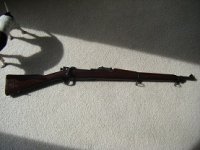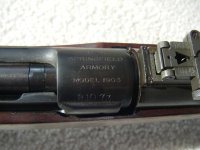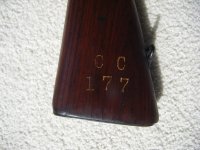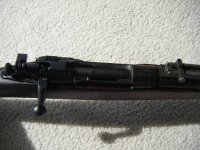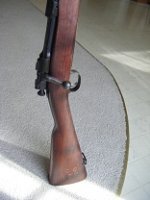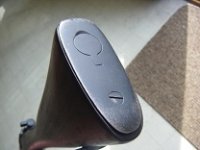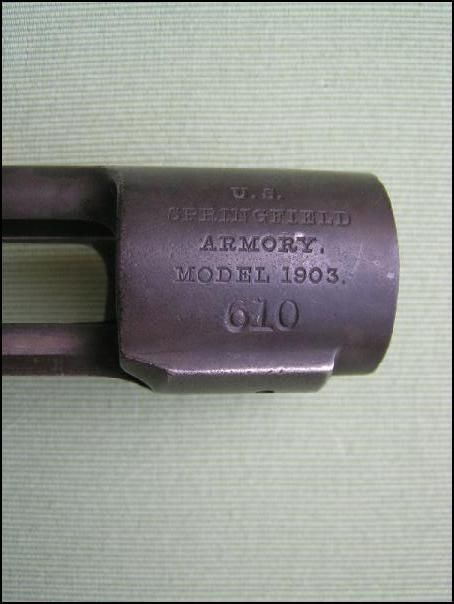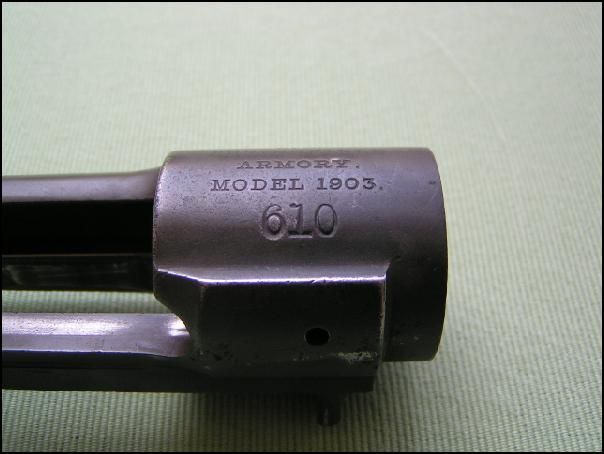You are using an out of date browser. It may not display this or other websites correctly.
You should upgrade or use an alternative browser.
You should upgrade or use an alternative browser.
1903 Springfield
- Thread starter PIGEONMAN
- Start date
The serial number of 81,000 places it in the single heat treat receiver range.
The pre 800,000 single heat treat receivers were in the process of being scrapped by the pre WW2 Army because of the quantity burnt in the forging room, which made the metal brittle.
There is no known non destructive test even today, to sort out the good single heat treat receivers from the bad ones. There fore there is risk in continued firing of a single heat treat receiver.
I would keep loads light or not shoot it at all.
Your pre WW1 receiver was rebarreled at some time with a 1943 barrel. I am unfamiliar with 1943 dated 03 barrels, never heard of an i-43 barrel, I have seen HS to 44 and SA barrels only to 1942. Maybe your barrel is an 03A3 barrel?
Pictures would help.
The pre 800,000 single heat treat receivers were in the process of being scrapped by the pre WW2 Army because of the quantity burnt in the forging room, which made the metal brittle.
There is no known non destructive test even today, to sort out the good single heat treat receivers from the bad ones. There fore there is risk in continued firing of a single heat treat receiver.
I would keep loads light or not shoot it at all.
Your pre WW1 receiver was rebarreled at some time with a 1943 barrel. I am unfamiliar with 1943 dated 03 barrels, never heard of an i-43 barrel, I have seen HS to 44 and SA barrels only to 1942. Maybe your barrel is an 03A3 barrel?
Pictures would help.
Regardless of the barrel on the pre 800k Springfields, I recommend it not be fired:
I am a CMP GSM MI and conduct clinics and matches. I will not let anyone fire a low number 1903 to be used at any of my matches.
From the CMP Web Site:
I am a CMP GSM MI and conduct clinics and matches. I will not let anyone fire a low number 1903 to be used at any of my matches.
From the CMP Web Site:
M1903*
WARNING ON “LOW-NUMBER” SPRINGFIELDS
M1903 rifles made before February 1918 utilized receivers and bolts which were single heat-treated by a method that rendered some of them brittle and liable to fracture when fired, exposing the shooter to a risk of serious injury. It proved impossible to determine, without destructive testing, which receivers and bolts were so affected and therefore potentially dangerous.
To solve this problem, the Ordnance Department commenced double heat treatment of receivers and bolts. This was commenced at Springfield Armory at approximately serial number 800,000 and at Rock Island Arsenal at exactly serial number 285,507. All Springfields made after this change are commonly called “high number” rifles. Those Springfields made before this change are commonly called “low-number” rifles.
In view of the safety risk the Ordnance Department withdrew from active service all “low-number” Springfields. During WWII, however, the urgent need for rifles resulted in the rebuilding and reissuing of many “low-number” as well as “high-number” Springfields. The bolts from such rifles were often mixed during rebuilding, and did not necessarily remain with the original receiver.
Generally speaking, “low number” bolts can be distinguished from “high-number” bolts by the angle at which the bolt handle is bent down. All “low number” bolts have the bolt handle bent straight down, perpendicular to the axis of the bolt body. High number bolts have “swept-back” (or slightly rearward curved) bolt handles.
A few straight-bent bolts are of the double heat-treat type, but these are not easily identified, and until positively proved otherwise ANY straight-bent bolt should be assumed to be “low number”. All original swept-back bolts are definitely “high number”. In addition, any bolt marked “N.S.” (for nickel steel) can be safely regarded as “high number” if obtained directly from CMP (beware of re-marked fakes).
CMP DOES NOT RECOMMEND FIRING ANY SPRINGFIELD RIFLE WITH A ”LOW NUMBER” RECEIVER. Such rifles should be regarded as collector’s items, not “shooters”.
Bear River
New member
That is good Info. on the bolt handles. Never knew about that Thx.
tahunua001
New member
I just want to point out that a rifle with that low of serial number was almost certainly used in combat especially if its barrel was replaced in 1943, if it was unsafe to fire then it probably wouldn't have survived long enough to need a new barrel. I have a 1912 with a 1919 barrel that is also one of the unsafe to fire models but I still fire it all the time. with that said, your serial dates to 1904 so I would definitely refrain from shooting a great deal....that is a very early model and is worth a great deal to a collector assuming it hasn't been sporterized, drilled, and tapped.
EDIT the barrel marking is more than likely marked 1-43 which I believe means January 1943.
EDIT the barrel marking is more than likely marked 1-43 which I believe means January 1943.
Low #s
You have to make your own decisions, of course, about the risk, if any, in firing your rifle.
It is significant, I believe, that your receiver was manufactured in 1904, endured all of WWI, and was not declared unsafe until the Ordnance report in 1929, twenty five years later.
"at least sixty-eight cases had been reported (between 1917 and 1929).... that as a result of cartridge case failure due to soft brass, excess headspace, or high pressure, gas from the cartridge was allowed to get inside the receiver. A weak or brittle receiver would then rupture." (Brophy, p. 557)
Pete
You have to make your own decisions, of course, about the risk, if any, in firing your rifle.
It is significant, I believe, that your receiver was manufactured in 1904, endured all of WWI, and was not declared unsafe until the Ordnance report in 1929, twenty five years later.
"at least sixty-eight cases had been reported (between 1917 and 1929).... that as a result of cartridge case failure due to soft brass, excess headspace, or high pressure, gas from the cartridge was allowed to get inside the receiver. A weak or brittle receiver would then rupture." (Brophy, p. 557)
Pete
Something does not look correct in those pictures.
I have never seen a serial number so sloppily stamped as yours.
Looking at my “Springfield 1903 book”, your receiver has the small seriff letters, which according to the book, the latest serial number the author observed these were on a receiver numbered around 60, 400. Those last two digits are mis aligned and I have never seen a 03 with mis aligned numbers.
Then the sight base should but up against the receiver. You have a gap.
That is a A3 stock and A3 bolt.
It is very possible that this is a rifle put together from parts. I do not believe this was assembled in an American Arsenal or by professional armorers.
I have never seen a serial number so sloppily stamped as yours.
Looking at my “Springfield 1903 book”, your receiver has the small seriff letters, which according to the book, the latest serial number the author observed these were on a receiver numbered around 60, 400. Those last two digits are mis aligned and I have never seen a 03 with mis aligned numbers.
Then the sight base should but up against the receiver. You have a gap.
That is a A3 stock and A3 bolt.
It is very possible that this is a rifle put together from parts. I do not believe this was assembled in an American Arsenal or by professional armorers.
There is something very wrong with that receiver marking, and it is not just the serial number. That size and style of lettering was never used on any M1903 made by anyone, and certainly not by Springfield Armory.
I have no idea who marked that rifle, or even who made it, but please have it thoroughly checked out before even thinking of firing it. The concern about "low number" M1903 rifles is valid, but that may not even be a genuine M1903, or it could be one that was worked on at some unknown time and unknown place by some unknown organization or person.
Note that the rear sight does not contact the receiver; what that means, I don't know, but it is something else that is not right.
I STRONGLY advise having that rifle examined by a competent gunsmith; I suspect it might be a zinc cast dummy rifle receiver that has had a genuine barrel put on it in place of the original unchambered dummy barrel.
Jim
I have no idea who marked that rifle, or even who made it, but please have it thoroughly checked out before even thinking of firing it. The concern about "low number" M1903 rifles is valid, but that may not even be a genuine M1903, or it could be one that was worked on at some unknown time and unknown place by some unknown organization or person.
Note that the rear sight does not contact the receiver; what that means, I don't know, but it is something else that is not right.
I STRONGLY advise having that rifle examined by a competent gunsmith; I suspect it might be a zinc cast dummy rifle receiver that has had a genuine barrel put on it in place of the original unchambered dummy barrel.
Jim
tahunua001
New member
I also agree that somethings fishy about it. the serial is off centered and is a different font style and size from the manufacturer marking.
I agree with the last few posters, those receiver markings aren't from any U.S. arsenal, and if represented as such by the seller then I would be looking to get my money back.
While the early 1903's used a much more "curly" font, here is what the typical size/alignment of the receiver markings on a 1903 Springfield Armory rifle should look like. Also notice that the rear sight base is abutted right against the front of the receiver.

While the early 1903's used a much more "curly" font, here is what the typical size/alignment of the receiver markings on a 1903 Springfield Armory rifle should look like. Also notice that the rear sight base is abutted right against the front of the receiver.

madcratebuilder
New member
I have no idea who marked that rifle, or even who made it, but please have it thoroughly checked out before even thinking of firing it. The concern about "low number" M1903 rifles is valid, but that may not even be a genuine M1903, or it could be one that was worked on at some unknown time and unknown place by some unknown organization or person.
Note that the rear sight does not contact the receiver; what that means, I don't know, but it is something else that is not right.
I STRONGLY advise having that rifle examined by a competent gunsmith; I suspect it might be a zinc cast dummy rifle receiver that has had a genuine barrel put on it in place of the original unchambered dummy barrel.
+100
Appears to be a counterfeit rifle.
highpower3006
New member
I agree the the receiver looks as though it was renumbered. The style of lettering is the very early style, which may or may not predate the serial number, but what raises my red flag is the uneven stamping of the numbers. The armory was very quality conscious and I doubt if it would have ever released a receiver that was stamped like that.
I don't currently have a '03 that early, but here is a picture of my early 1906 Springfield, like the later one already pictured, note how straight the number is.

I don't currently have a '03 that early, but here is a picture of my early 1906 Springfield, like the later one already pictured, note how straight the number is.

I did not look at the pictures, really bad on me. Could be really bad on you.
There is something seriously wrong with the setup.
As the other noted, numbers do not look right and the sight base is not right.
Not sure how you would do a forgery like that, but it sure looks like one.
Do not even think about shooting it.
Full investigation and then make an informed decision on whats found.
There is something seriously wrong with the setup.
As the other noted, numbers do not look right and the sight base is not right.
Not sure how you would do a forgery like that, but it sure looks like one.
Do not even think about shooting it.
Full investigation and then make an informed decision on whats found.

